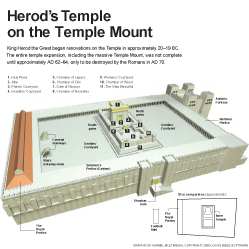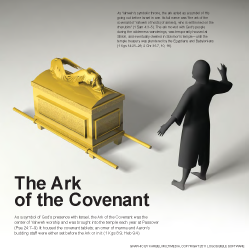11:1–14 These verses comprise the second interlude between the sixth and seventh trumpet judgments. Similar to ch. 7 during the seal judgments, ch. 10 and this episode in ch. 11 disrupt the sequence of events. John introduces the concept of measuring the temple to connote God’s protection and preservation of His people. He also presents two witnesses as God’s prophetic harbingers of impending wrath. |
11:1 was given Perhaps by the angel from ch. 10 or by God.
a measuring rod A staff with a standardized length used for taking measurements.
measure This suggests God’s protection of the people located within the measured area (compare Zech 2:1–5; Rev 21:15–17). Their preservation from spiritual harm recalls the sealing activity of ch. 7, where the 144,000 are protected prior to the opening of the seventh seal, the unleashing of the trumpet judgments, and the unleashing of the demonic forces of ch. 9 (see 9:4).
temple of God The Jerusalem temple could have been destroyed by the time John wrote his apocalypse. This temple may refer to a future rebuilt temple, the heavenly temple mentioned elsewhere in Revelation, or the church as God’s temple, either throughout history or in a final tribulation period (see note on 1:19; compare vv. 19; 1 Cor 3:16).
11:2 the courtyard outside of the temple Refers to the court of the Gentiles, the designated space for non-Jews visiting the temple. Gentiles who ventured beyond its confines into the holy place risked death if caught.
Gentiles Contrasted with those who worship in the sanctuary, the Gentiles here represent unbelievers, upon whom judgment is coming (compare Rev 11:1).
forty two months Restated in v. 3 as 1,260 days (compare 12:6; 13:5). Both figures define, according to traditions from Daniel, the length of the persecution of God’s people (e.g., Dan 7:25; 12:11–12). This could refer literally to a future tribulation or symbolically to the whole amount of time between Jesus’ first and second comings, when God’s people are under pressure from the nations (compare Rev 7:14).
11:3 my two witnesses The identity of these two figures is unknown. They may be symbolic of the overall witness of the Church during tribulation. Alternatively, these two witnesses may be actual prophets who come to earth and proclaim God’s message.
one thousand two hundred sixty days See note on v. 2.
dressed in sackcloth Suggesting their somber ministry and their calling of the nations to repentance.
11:4 the two olive trees This echoes the reference in Zechariah to two anointed ones (Zech 4:11–14). These may be identified with the postexilic high priest Joshua and the Davidic descendant Zerubbabel, both of whom were instrumental in the temple restoration efforts (see Zech 4:1–14). John seems to be appropriating this tradition of priestly and kingly figures and reapplying it to his two witnesses.
the two lampstands Earlier in Revelation, lampstands are identified with the churches (Rev 1:12, 20). Only two of these churches (Smyrna and Philadelphia) were entirely faithful and received no rebuke. The two witnesses thus may be a symbol of the Church bearing faithful witness.
11:5 fire comes out of their mouth May be representative of the kind of condemnatory activity associated with the sword in Christ’s mouth (see 1:16; 2:12, 16; 19:15, 21).
11:6 to shut the sky Describes the ability to bring about drought-like conditions, similar to Elijah (see 1 Kgs 17:1).
over the waters Reminiscent of Moses (see Exod 7:17–21).
with every plague Recalls the exodus (see Rev 8:6 and note).
the abyss Where demons and fallen angels resided. See 9:1 and note.
will kill them They will be killed because of their prophetic ministry and message of Christ (see v. 6).
11:8 their dead bodies will lie in the street The ultimate shame (see Isa 5:25; Psalms of Solomon 2:27).
Sodom and Egypt Used metaphorically to highlight spiritual corruption. In biblical literature Egypt is vilified for its oppression and idolatry, and Sodom
is vilified for its oppression and idolatry, and Sodom for its wickedness and immorality.
for its wickedness and immorality.
where also their Lord was crucified Refers to Jerusalem. However, since references to a great city are used throughout Revelation to describe Rome
However, since references to a great city are used throughout Revelation to describe Rome (figuratively called Babylon; see Rev 16–18), this phrase may also refer to Rome, since crucifixion was a distinctly Roman form of execution. It may even be that John has in mind all cities that oppose the work of God in the world.
(figuratively called Babylon; see Rev 16–18), this phrase may also refer to Rome, since crucifixion was a distinctly Roman form of execution. It may even be that John has in mind all cities that oppose the work of God in the world.
11:9 peoples and tribes and languages and nations John is immediately fulfilling his prophetic responsibility (see 7:9; compare 10:11).
three and a half days Related to the 42 months of v. 2 and the 1,260 days of v. 3—both of which signify a three-and-a-half-year period.
11:10 will send gifts to one another Their deaths will be commemorated by a holiday.
11:11 the breath of life John refers to resurrection, whether the two witnesses are interpreted as two individuals or the entire Church. John likely borrows this phraseology from Ezek 37:5, 9–10.
11:12 Come up here Reminiscent of Enoch and Elijah
and Elijah being taken up to heaven (see Rev 11:3 and note; Gen 5:24; 2 Kgs 2:11; compare Rev 4:1 and note).
being taken up to heaven (see Rev 11:3 and note; Gen 5:24; 2 Kgs 2:11; compare Rev 4:1 and note).
in a cloud See 10:1 and note; compare 1 Thess 4:17 and note.
11:13 gave glory to the God of heaven The intended goal of the judgments throughout the book (compare 9:20–21). Elsewhere in the Bible, this phrase sometimes refers to conversion (e.g., Matt 5:16; Luke 18:43); other times it serves as an expression of unbelievers forced to acknowledge the sovereignty of Israel’s God (e.g., Josh 7:19; 1 Sam 6:5).
 Doxa Word Study
Doxa Word Study
11:14 The second woe has passed The sixth trumpet judgment (see Rev 8:13 and note).
the third woe The seventh trumpet judgment (see v. 15).
11:15–19 At the sounding of the seventh trumpet, another violent outpouring of God’s wrath is expected. Instead, voices from heaven announce the arrival of God’s kingdom. A message of doom for the nations of the world is implied by this proclamation, but this is not initially accompanied by destruction. The result of the arrival of God’s kingdom is that He will once again dwell with His creation. |
11:15 seventh angel blew the trumpet This completes the cycle of seven trumpets. There is no woe explicitly stated in relation to this trumpet (see 8:13 and note).
of our Lord and of his Christ The kingdom of God and His Messiah has arrived. This was Daniel’s great hope, the prophets’ fervent desire, the focal point of Christ’s preaching, and the apostles’ goal.
11:17 We give thanks The only occurrence of the term “to give thanks” (eucharisteō) or its derivatives in Revelation.
have begun to reign God has always been sovereign over His creation; however, in John’s visions of the time of the end, God takes charge of the kingdoms of the world by setting His Messiah over them as king. This means the end of suffering for the people of God, the end of the kingdoms of the world, and the arrival of justice.
11:18 the small and the great Describes everyone without distinction, whether ordinary or important.
those who destroy the earth The Greek term for “destroy” (diaphtheirō) refers to those who kill, murder, and oppress persons or nations.
11:19 the temple of God in heaven was opened Similar to v. 17, God dwells among His people, and they have unrestricted access to Him (compare Mark 15:38 and note).
the ark of his covenant While the ark of the covenant is presumed to have been destroyed during Nebuchadnezzar’s final siege of Jerusalem (586 bc), its fate is unknown. The ark was the locus of God’s presence with His people and the symbol of His covenant with them, and here it carries the same significance (compare Rev 21:3).
is presumed to have been destroyed during Nebuchadnezzar’s final siege of Jerusalem (586 bc), its fate is unknown. The ark was the locus of God’s presence with His people and the symbol of His covenant with them, and here it carries the same significance (compare Rev 21:3).

|
About Faithlife Study BibleFaithlife Study Bible (FSB) is your guide to the ancient world of the Old and New Testaments, with study notes and articles that draw from a wide range of academic research. FSB helps you learn how to think about interpretation methods and issues so that you can gain a deeper understanding of the text. |
| Copyright |
Copyright 2012 Logos Bible Software. |
| Support Info | fsb |
 Loading…
Loading…



